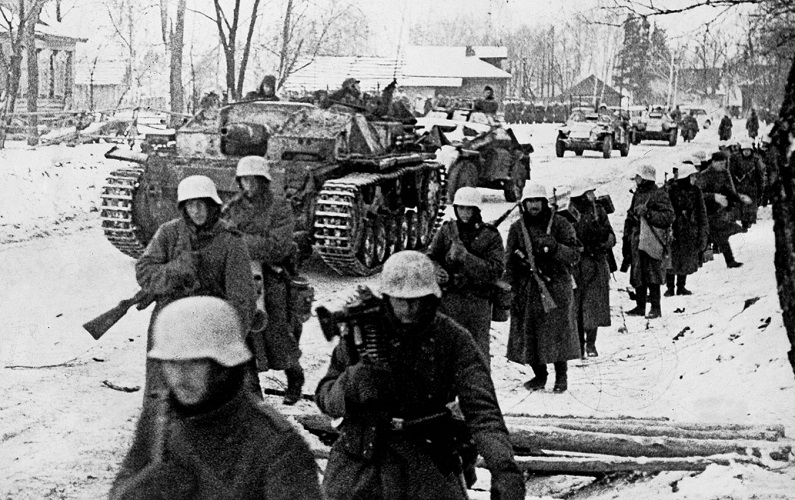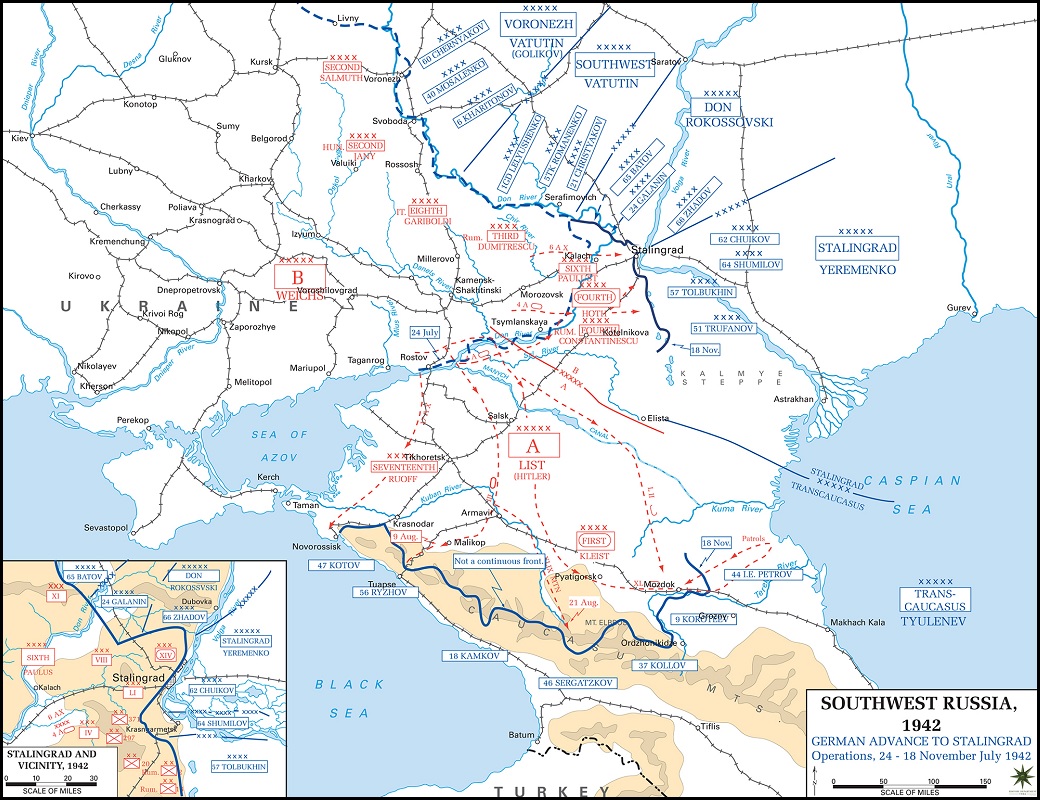● ● ●
The prelude to Operation
Barbarossa—the invasion of the USSR—erased such independence as the High Command of the Army (Oberkommando
des Heeres or OKH) still possessed. In his capacity as
supreme commander of the armed forces, Hitler decreed that
henceforth OKH would concern itself with the Russian front
exclusively. All other areas of operations were designated
as OKW (Oberkommando der Wehrmacht or High Command of
the Armed Forces) theaters of war. Thus unity of command, to
the extent that it could still be said to exist, was
embodied in Hitler’s person alone. The authority of the
Commander-in-Chief of the Army, Field Marshal Walther von
Brauchitsch, was circumscribed accordingly: He could no
longer issue orders to Army commands in the OKW theaters.
Hitler also took an
active hand in the planning of Barbarossa. He, von Brauchitsch
and the Chief of the General Staff, Colonel-General Franz
Halder, agreed that the first objective must be the
encirclement and destruction of the Soviet forces in the
border areas of the USSR. But they did not agree about what
should happen next. OKH argued that the main effort should
be made on the Moscow axis. Not only was the road and rail
net more extensive in that direction, but the Soviet
capital was a major industrial center and hub of
communications that the Red Army would no doubt be compelled to
defend, and whose loss might prove fatal to the Soviet
regime.
The Führer, however, had other
ideas: the capture of Leningrad and the seizure of Ukraine,
the USSR’s breadbasket and a major source of raw materials.
He argued that the loss of these territories would cripple
the Soviet war effort, and that their resources were
essential to sustain the German war effort. For the moment
this disagreement was papered over, Hitler telling
Brauchitsch and Halder that a final decision on future
operations would be made after the successful conclusion of
Barbarossa’s first phase.

German troops in Russia,
winter 1941-42 (Bundesarchiv)
But as things turned out,
the division of command responsibility and Hitler’s
non-decision on the second phase of Barbarossa stored up
trouble for the future. All might have been well if
the Russian campaign could have been finished off as planned
by the autumn of 1941. But for various reasons, prominent
among them the Germans’ underestimation of the USSR’s
military resources, this proved impossible. The last
lingering hopes for a quick victory dissipated with Hitler’s
decision to halt the drive on Moscow in July 1941 and divert
forces to the north and south, grasping for Leningrad and the
Ukraine. But the drive on Leningrad failed, leaving the city
besieged but still in Russian hands. And though a great victory was won at Kiev,
with some 600,000 troops of the Red Army killed, wounded or
made prisoner, strategically it led nowhere. Finally, when the
attack on Moscow was belatedly resumed in September it lacked sufficient
punch and stalled out with the onset of winter. Then came
the shock of the
first Soviet winter counteroffensive, which
for a time seemed to threaten the German Army with a defeat
of Napoleonic proportions. Though the immediate crisis was
mastered, it was clear to the generals and even to Hitler that Barbarossa had failed. The war in the east would go on—and
German’s prospects for winning it appeared increasingly
doubtful.
These alarming
developments had both short- and long-term consequences.
First, the Red Army’s 1941-42 counteroffensive provoked a
command shakeup on the German side, with many senior
officers dismissed. Once it became obvious that Moscow could
not be captured, the generals had advocated a general
withdrawal to a defensible winter line, but to this the Führer was adamantly opposed. He argued,
perhaps correctly,
that such a retreat would devolve into a rout, and demanded
instead
an all-out defense in place. Hitler got his way in this by
the simple expedient of dismissing von Brauchitsch and putting himself in direct command of
the Army. He thus united in his person the offices of head
of state, supreme commander of the armed forces as a whole,
and commander-in-chief of the Army. No longer could any
other individual or institution claim independent military
authority or responsibility. In effect, OKH was reduced to
the status of Hitler’s planning and operations staff for the
Eastern Front only. But even this relationship was
undermined by his distrust of the generals and the General
Staff as a whole—a distrust that developed into a mania as
the war went on and the tide turned against Germany.
The fragmentation of
military authority intensified the already bitter rivalry
between OKH and OKW, exemplified by endless wrangling over the
allocation of forces among the various fronts. One of the
key responsibilities of a military high command in wartime
is the management of reserves and military resources
generally. But by 1941 there existed in National Socialist
Germany no such responsible body. Only Hitler,
standing alone at the apex of a jury-rigged command
structure, could take fundamental decisions. And though on
more than a few occasions his judgment proved superior to
that of the
Generalität, the Führer
was unfitted by temperament or training for such a task: He had no
respect for institutions nor any understanding of corporate responsibility. Only
his will mattered—and the worse things went for
Germany, the more completely was the will of the Führer
substituted for rational calculation.

Department of History,
USMA West Point
The disastrous results of
the 1942-43 campaign, beginning with the German summer
offense in the southern USSR and ending with the Stalingrad
debacle, laid bare both the impotence of OKH and the bankruptcy of German strategy.
Hitler’s decision to divide his forces in the southern USSR,
sending part toward Stalingrad on the Volga and part into
the Caucasus, was a grave strategic error, compounded by the Führer’s burgeoning obsession with the capture of the “city
of Stalin.” This set the stage for the second Soviet winter
counteroffensive, which trapped and destroyed Sixth Army at
Stalingrad. Coming as it did on top of defeat at El Alamein
in North Africa, Stalingrad clearly signaled the
psychological if not quite the military turning point of the
war.
In this way Stalingrad extinguished the last smoldering ashes of OKH's autonomy. From mid-1943 to the end
of the war, the High Command of the Army existed in name
only. Hitler had stripped it of all authority so that the
penultimate Chief of the OKH, Colonel-General Heinz Guderian,
appointed after the attempt on the Führer’s life (20 July
1944) spent much of his time in futile wrangling over petty
military details as Germany plunged inexorably into the
abyss of defeat. To that humiliating and dishonorable end
was the OKH brought by the devil’s bargain it had struck with Adolf Hitler and National Socialism.
● ● ●